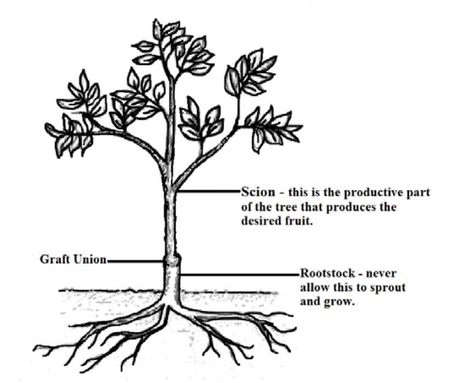Citrus Sprouting Rootstock
Nursery-grown citrus plants generally consist of a desirable variety grafted onto a rootstock cultivar.
 Citrus graft junctionImage source: Citrus Problems — Sprouting Rootstock, Louisiana State University Extension
Citrus graft junctionImage source: Citrus Problems — Sprouting Rootstock, Louisiana State University Extension
"The rootstock cultivar makes up the lower few inches of the trunk and the tree’s roots. The scion cultivar makes up the rest of the trunk and all the branches, leaves, and fruit. Rootstocks are selected for their improved disease and nematode resistance, tolerance to adverse soil conditions, nutrient uptake, cold hardiness, and favorable influence on the performance of the scion cultivar, including tree size (dwarfing effects), fruit quality (sugar-to-acid ratio, flavor, texture, size), and productivity (yield efficiency)."
Things to know:
- The point of connection between the desirable variety and the rootstock is the graft union. Refer to the illustration below.
- Prune all growth that originates from the rootstock, i.e. below the graft union.
- If it's difficult to locate the graft junction, sometimes it's possible to identify the source by the growth pattern of the branch. If there's a difference between the growth of branches higher vs. lower on the plant, it's possible the lower growth is from the rootstock. For citrus, this sometimes results in large thorns.
More information: Citrus Problems — Sprouting Rootstock, Louisiana State University Extension
 Citrus graft junction
Citrus graft junctionRelated Articles
Citrus Tree Problems
If you have problems with a citrus tree—including orange, lemon, lime—UC has resources that may help: Citrus Diseases and Disorders of Leaves and Twigs covers a range of problems including branch dieback, sooty mold, yellow leaves, and more. This ...Citrus Grafting
If you're interested in cloning citrus, you should know about the Citrus Clonal Protection Program (CCPP). The CCPP "provides a safe mechanism for the introduction into California of citrus varieties from any citrus-growing area of the world" and ...Citrus Leafminer
Unsightly leaves at the tips of new citrus branches are often caused by citrus leafminers. They originate from a tiny moth that lays eggs only on new citrus tree growth. Its larva then tunnels around inside the leaf, eating between the top and bottom ...Asian Citrus Psyllid
The most recent quarantine information related to the Asian Citrus Psyllid can be found on our website. The County is actively monitoring for this pest and coordinating treatment as needed.Why are my citrus leaves yellow (winter)?
Yellow citrus leaves are fairly common in late winter, often after winter fruit production and before spring new growth. You will want to apply fertilizer before the tree begins to bloom again. The UC Integrated Pest Management website has cultural ...